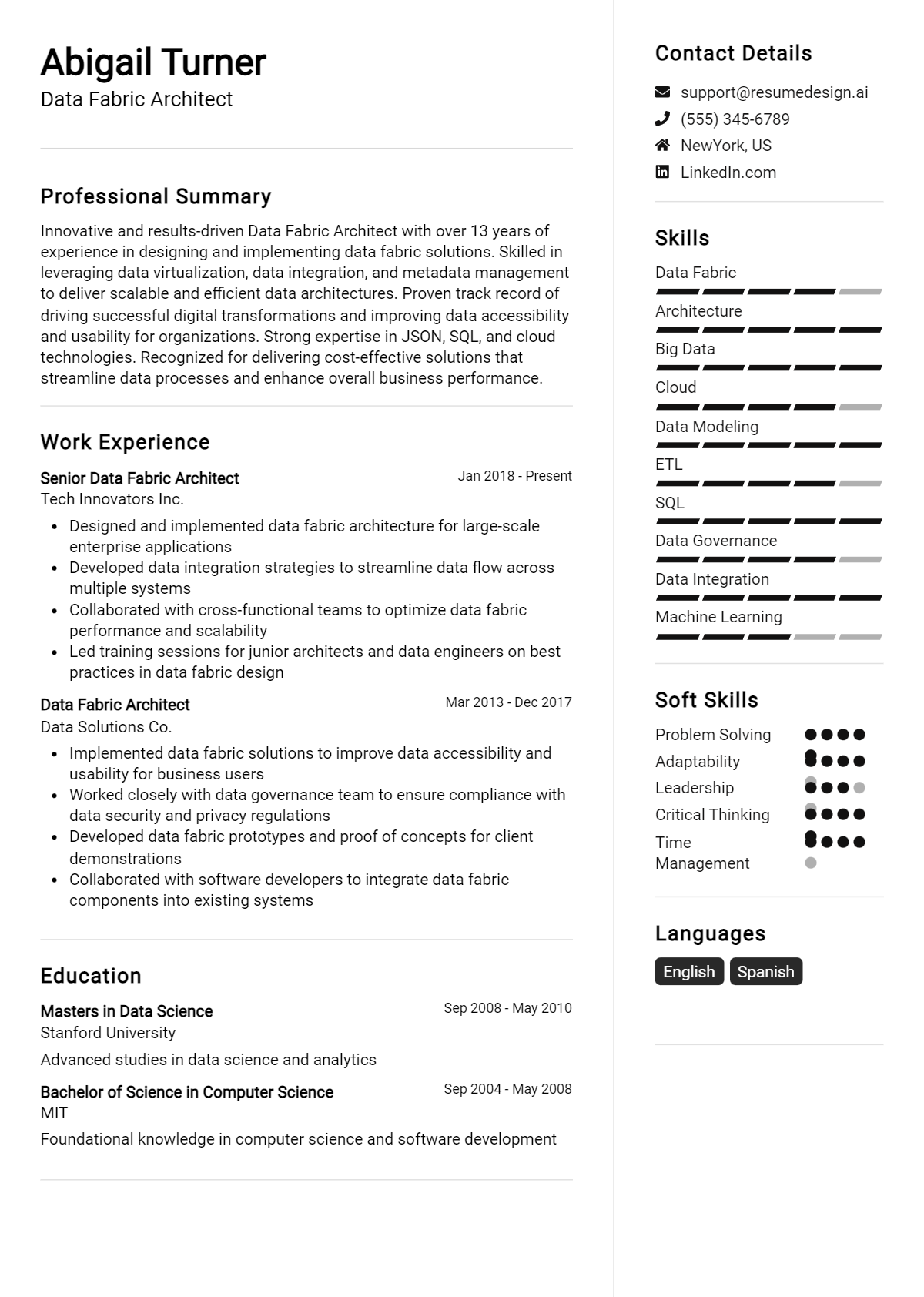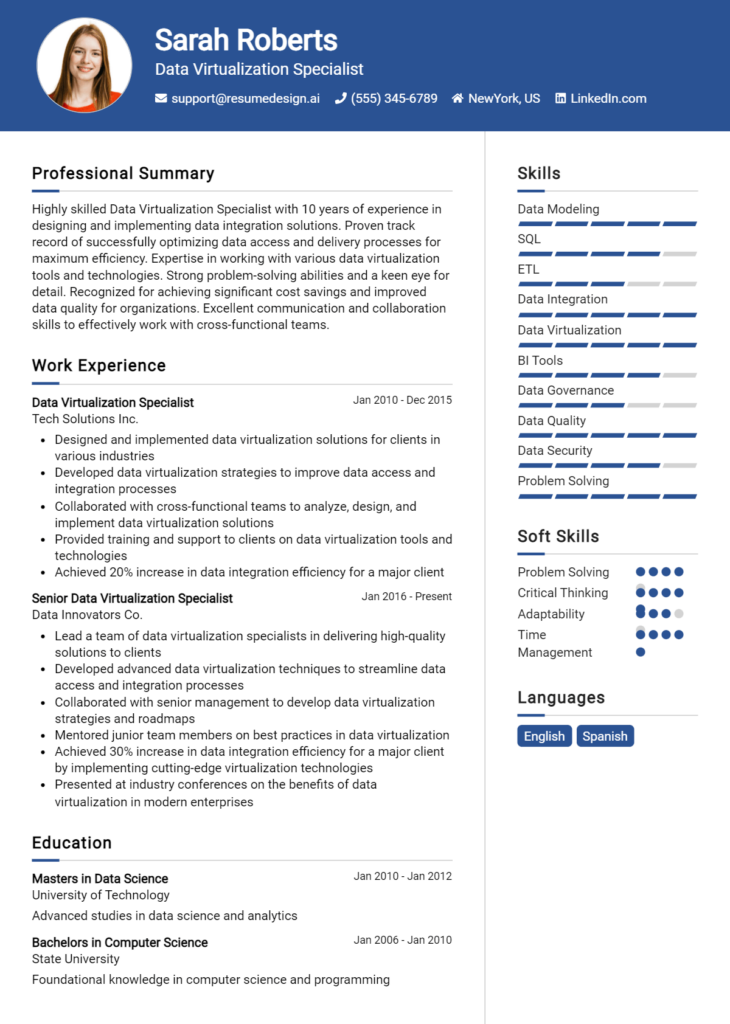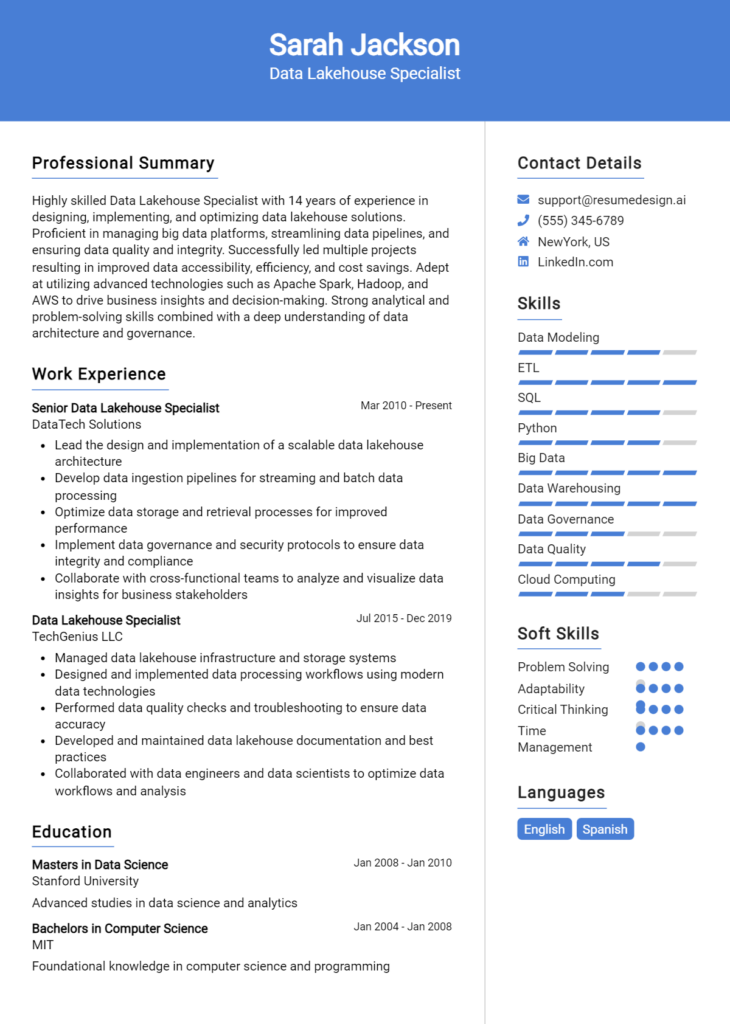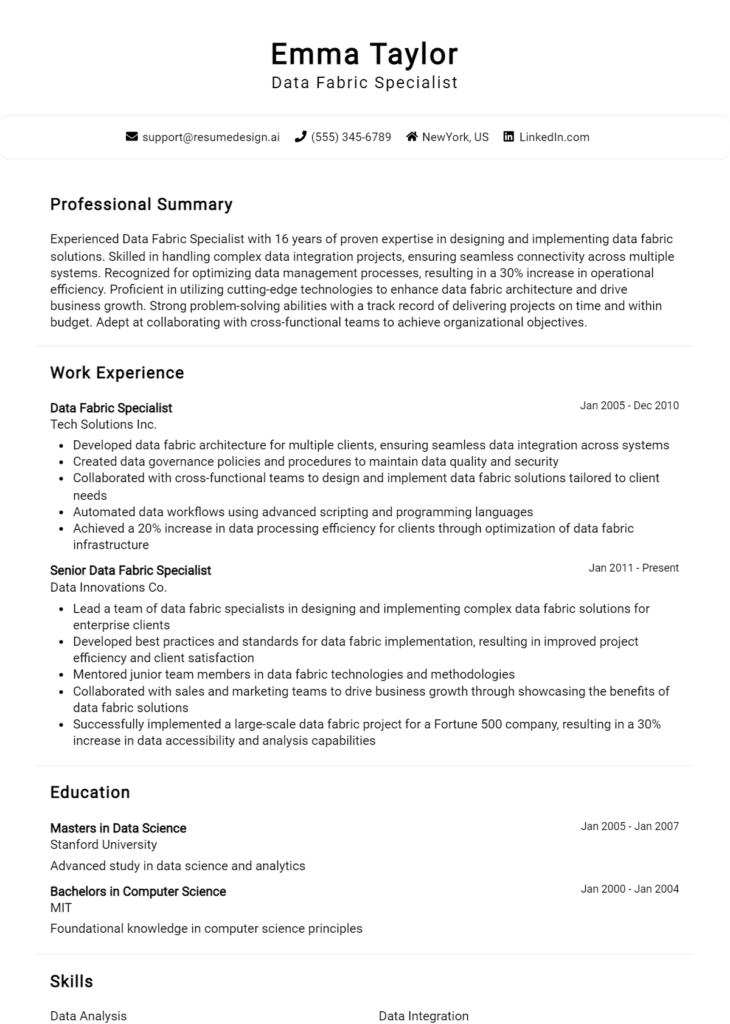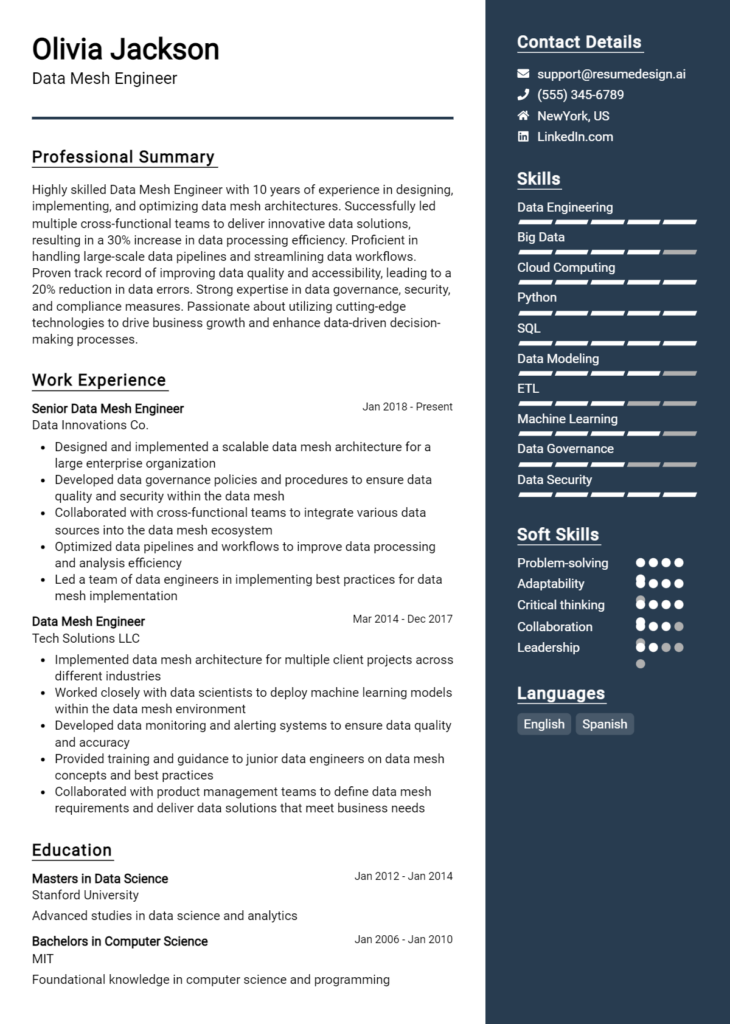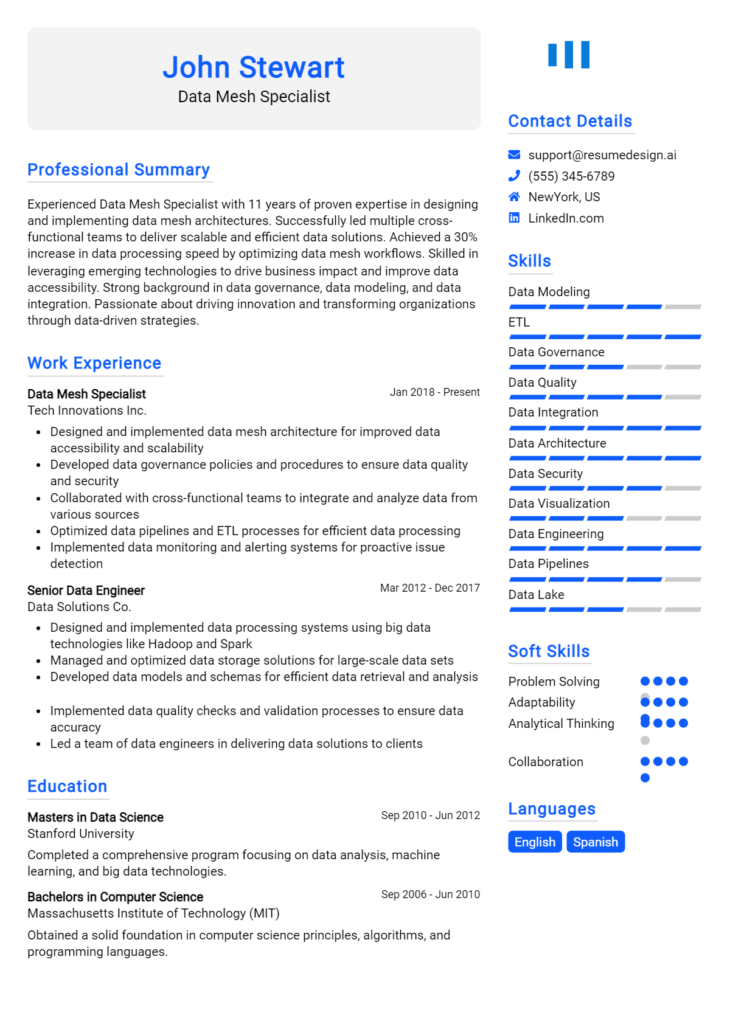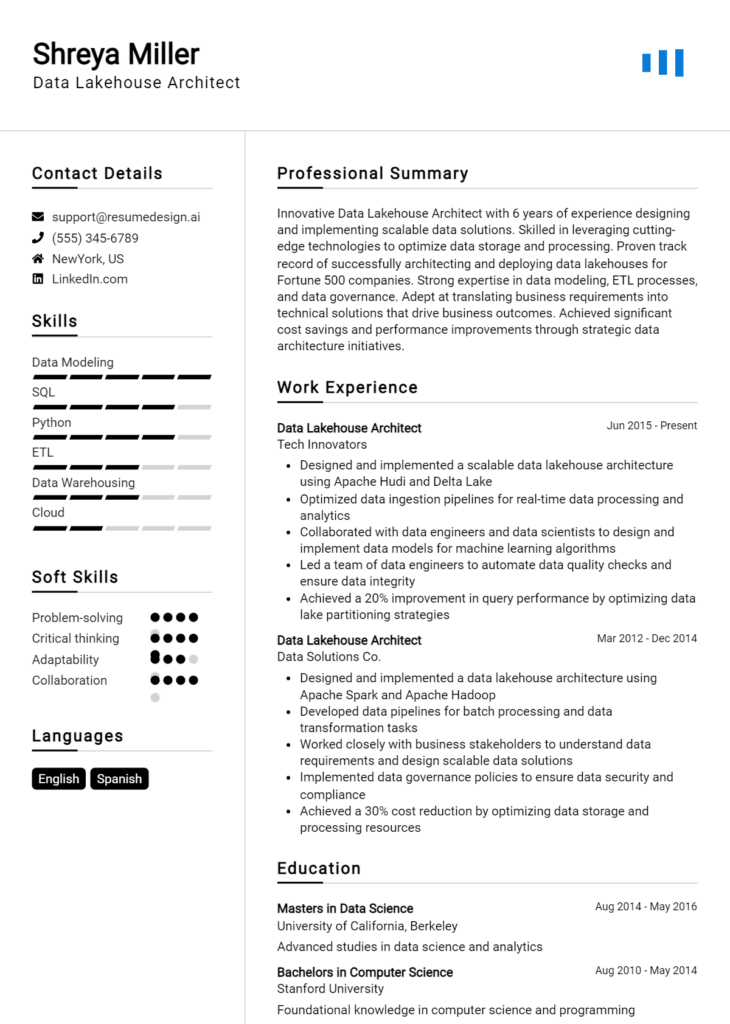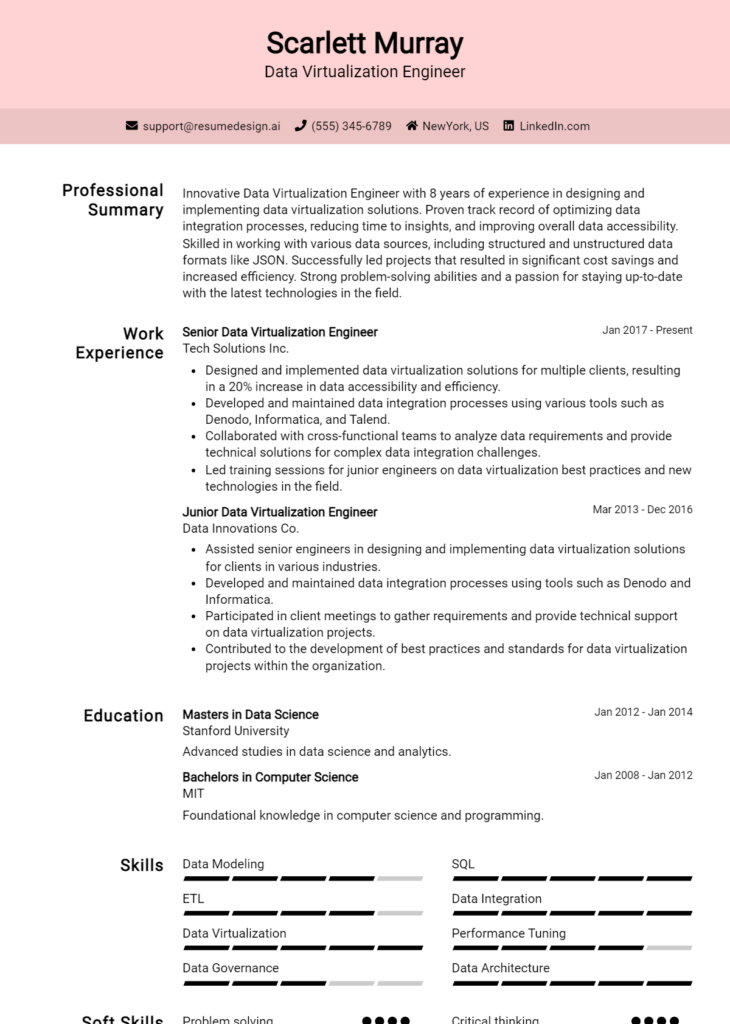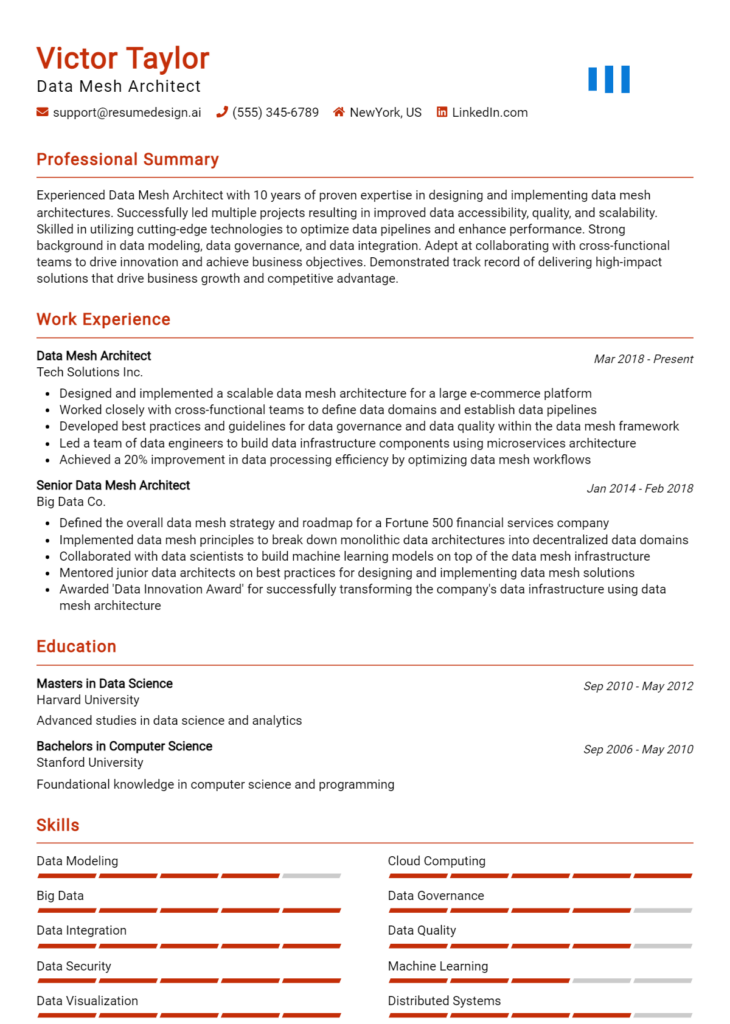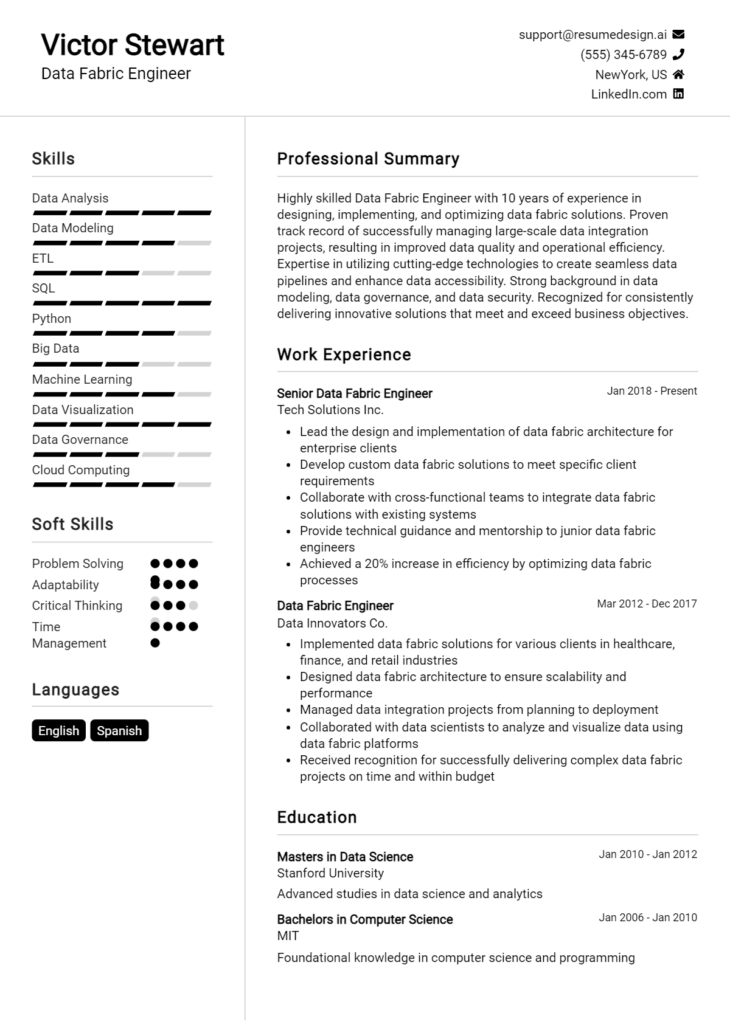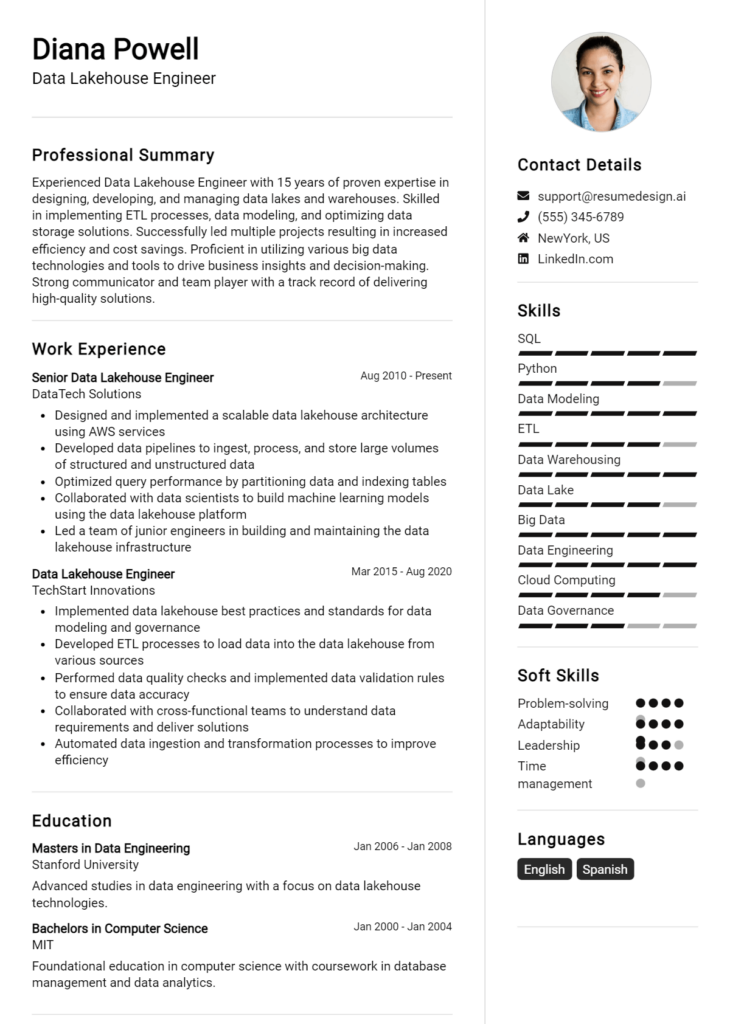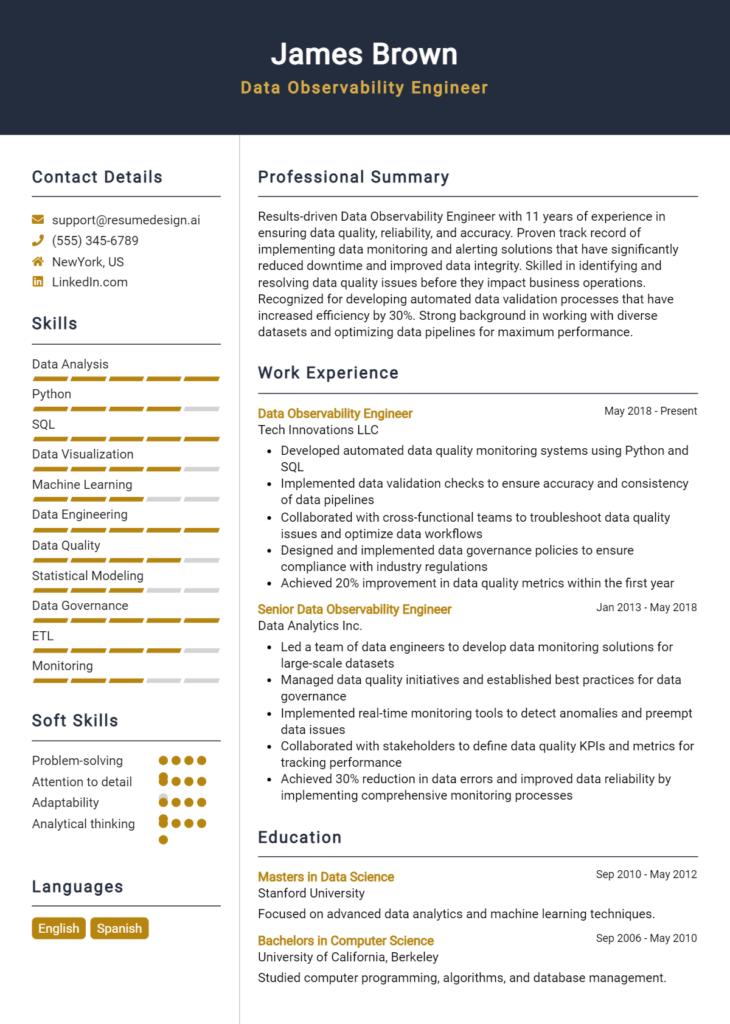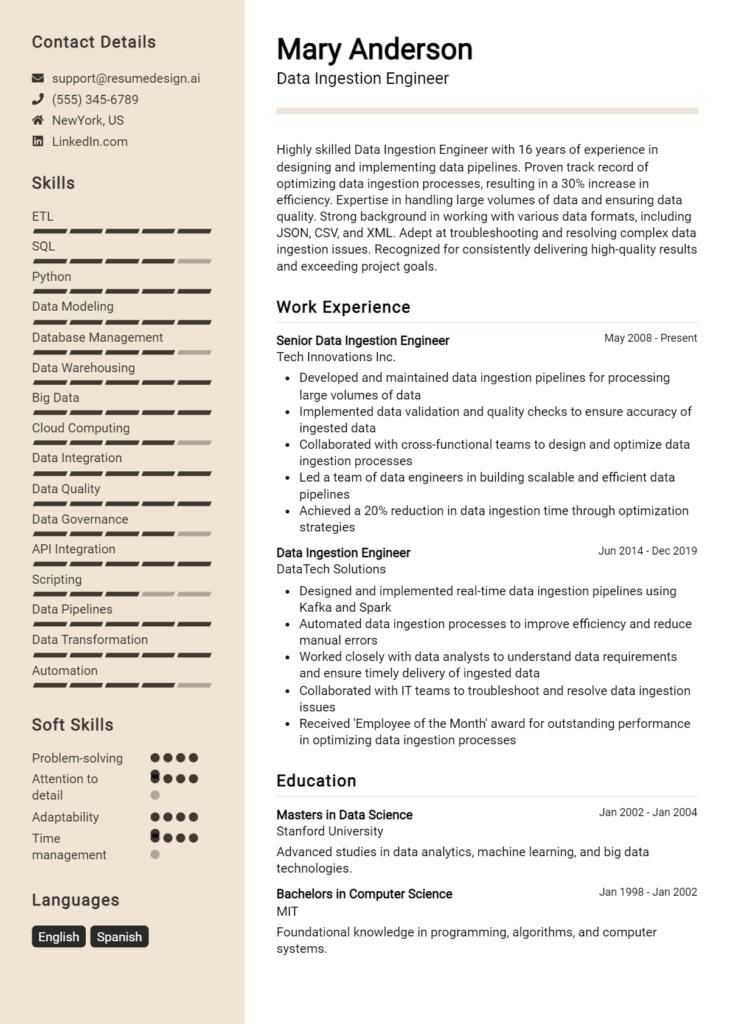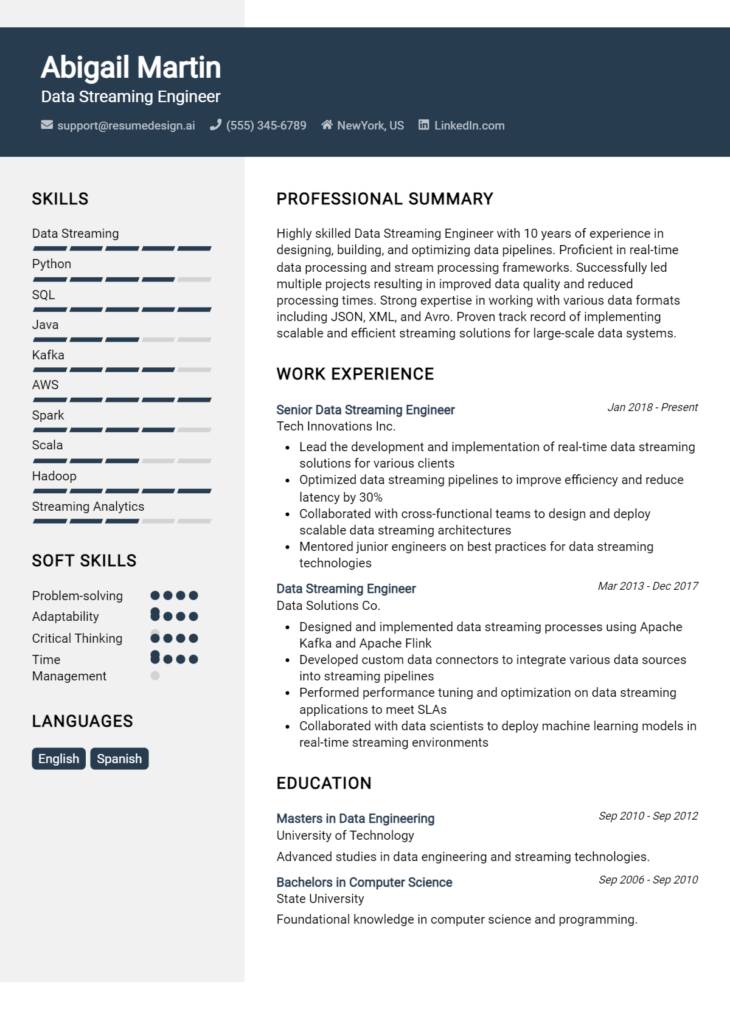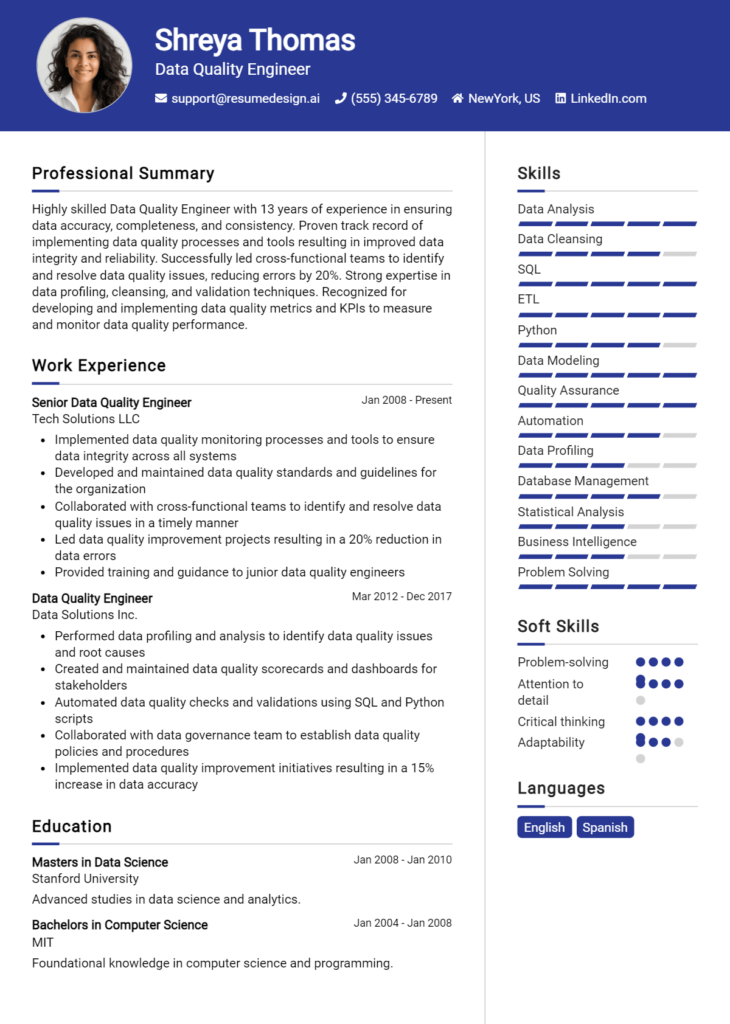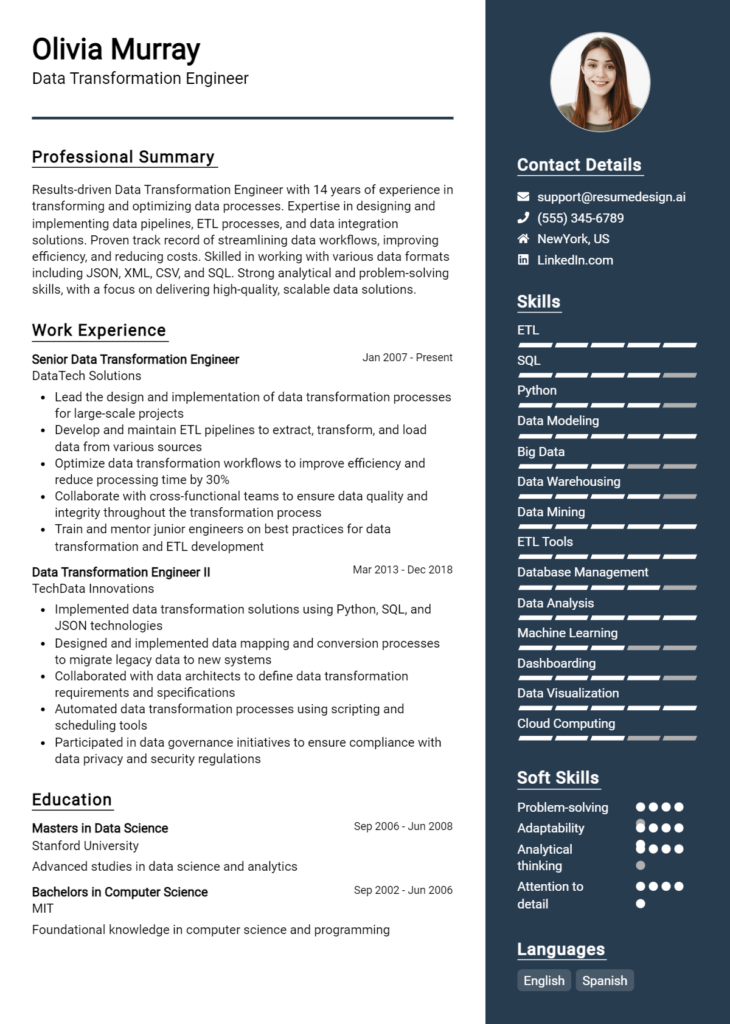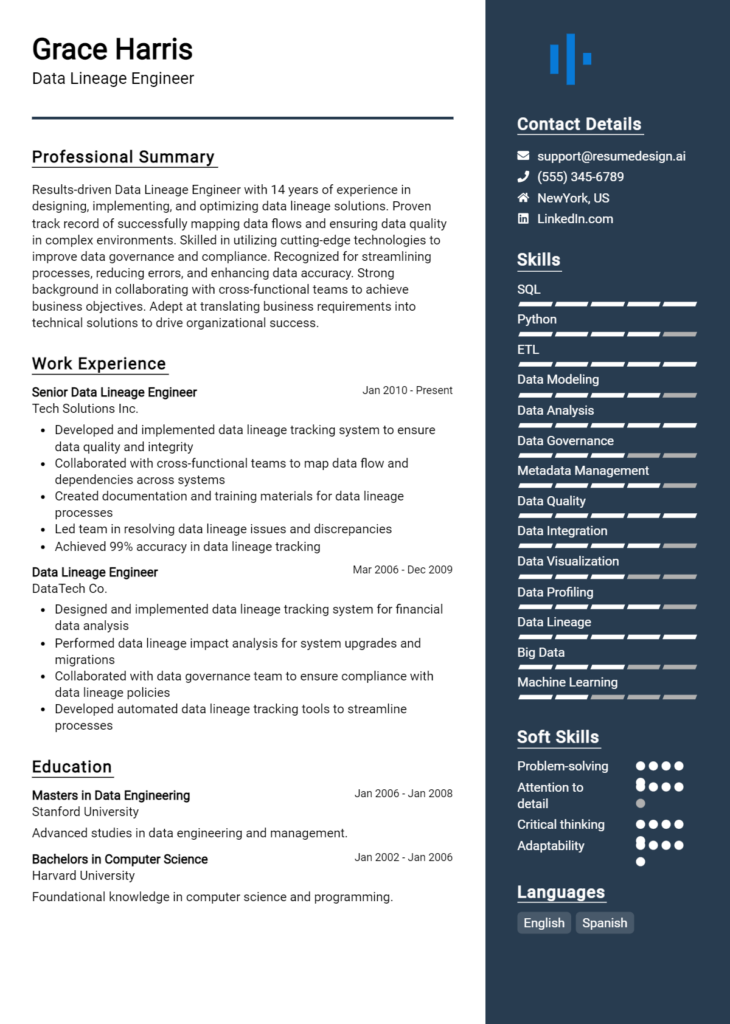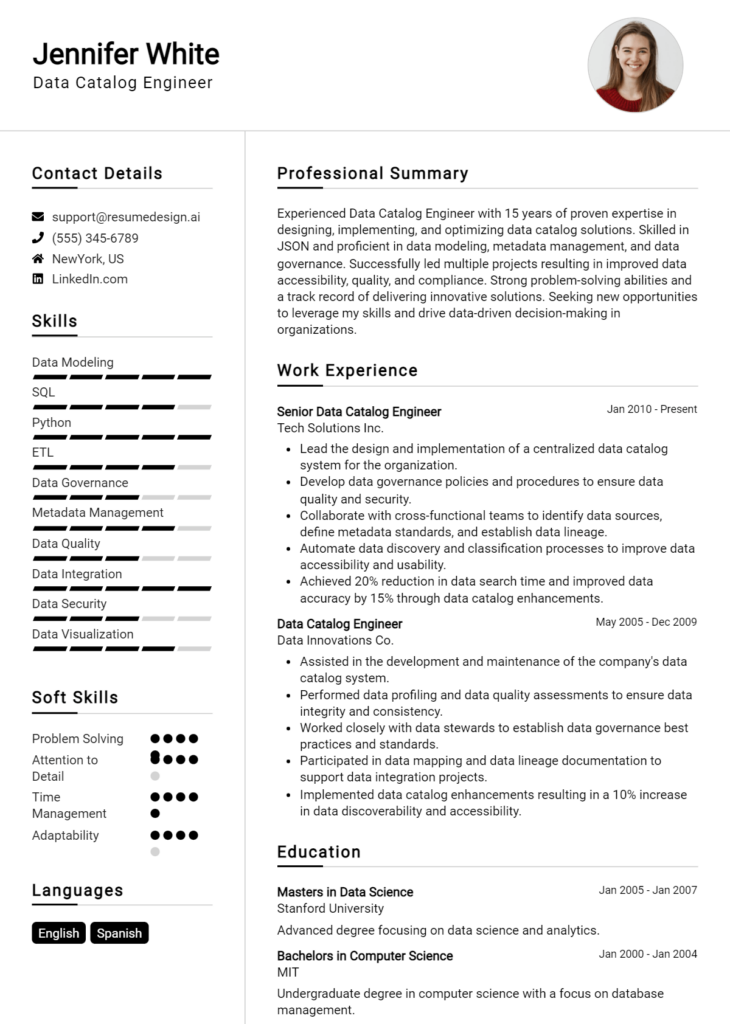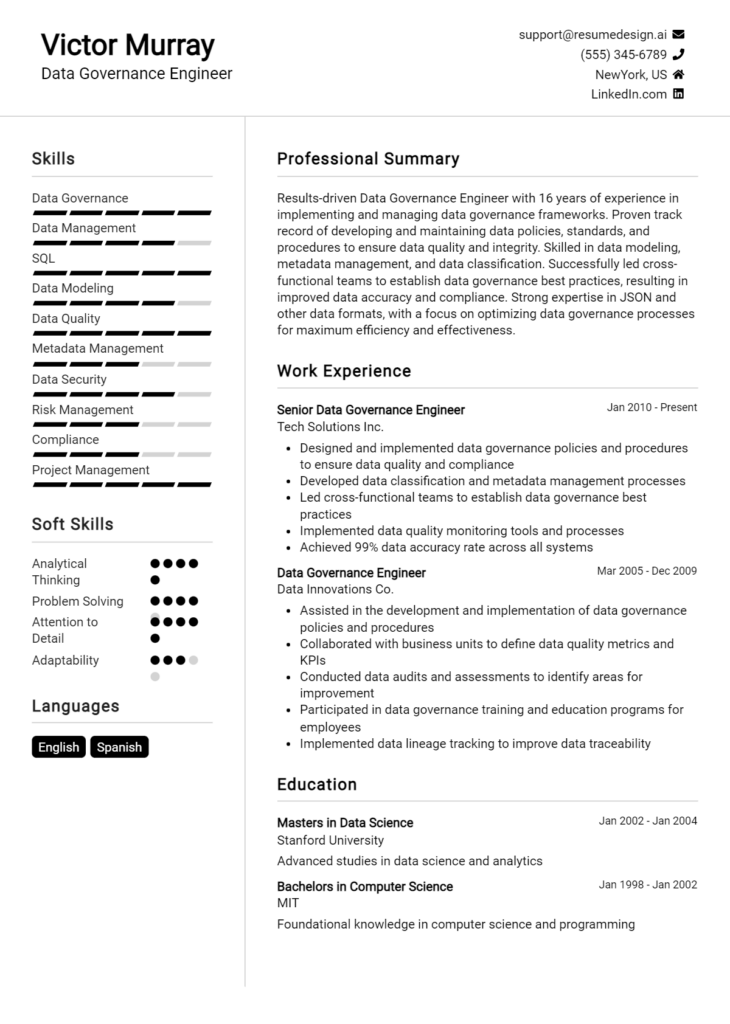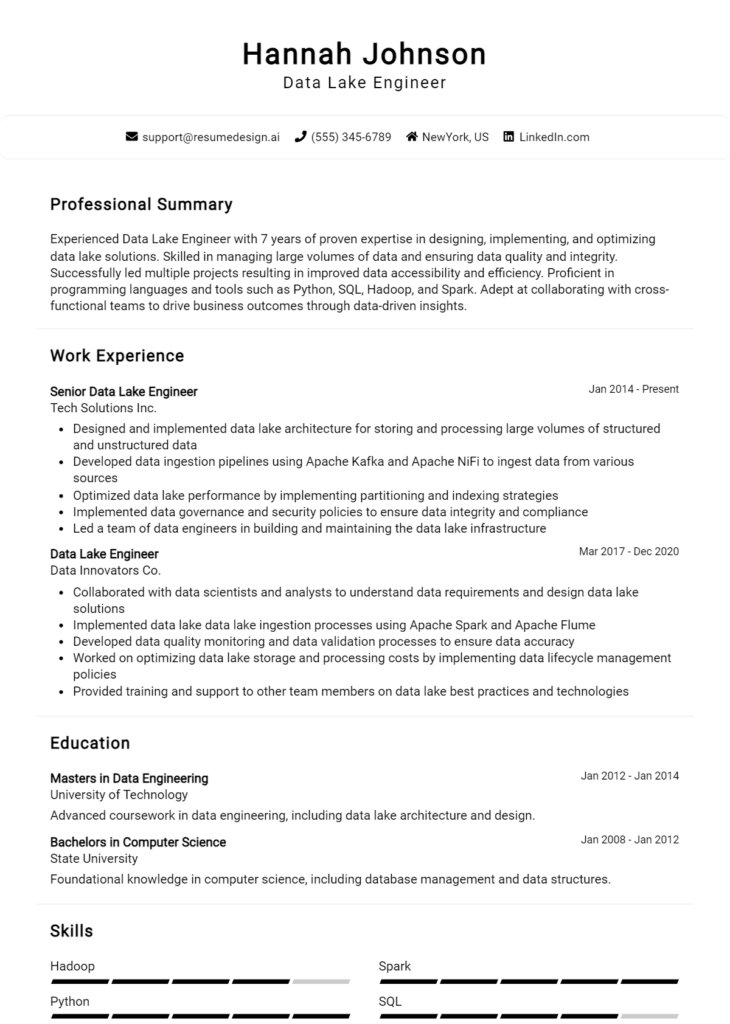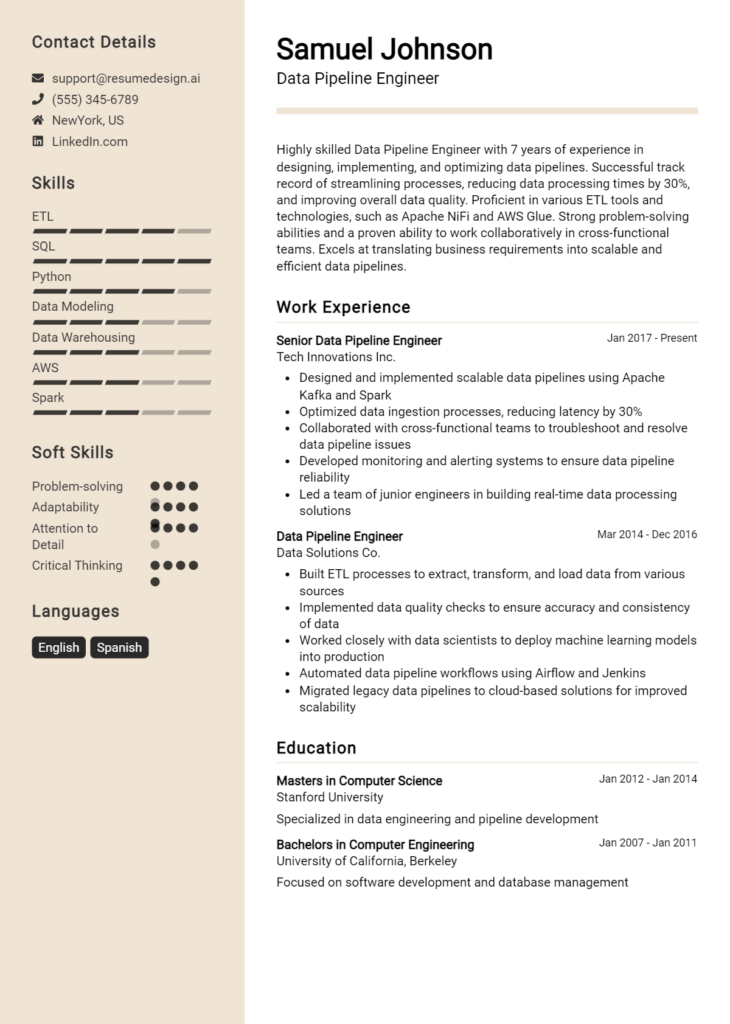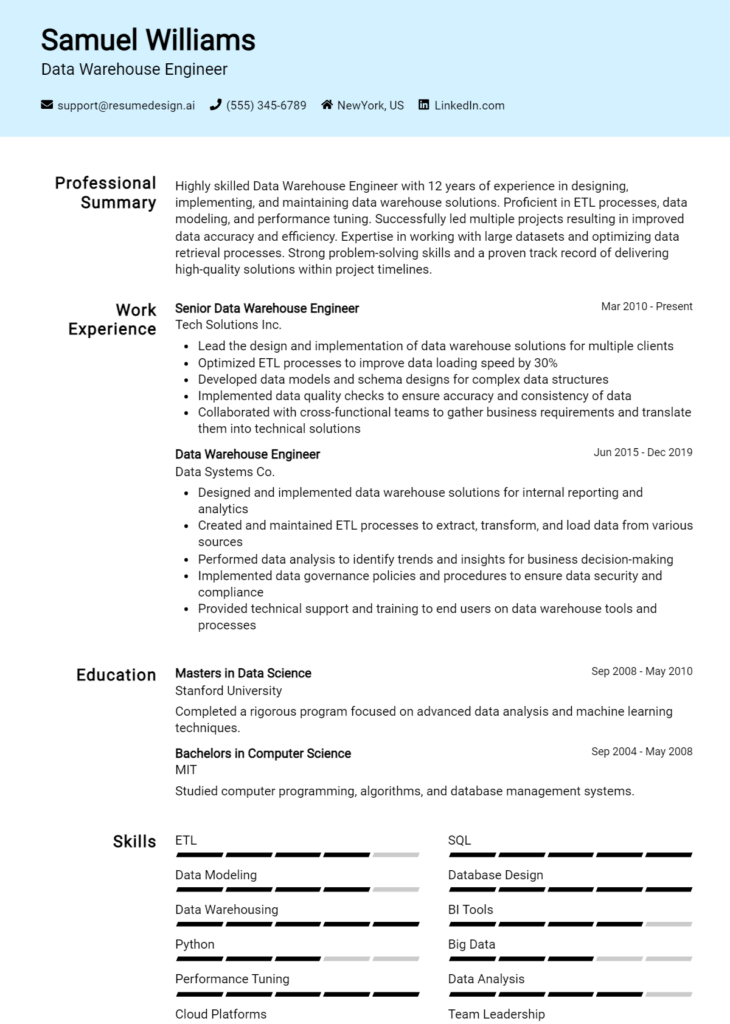Data Fabric Architect Core Responsibilities
A Data Fabric Architect is pivotal in integrating data across various departments, ensuring seamless access and management of information. Key responsibilities include designing data architectures, implementing data governance policies, and optimizing data workflows. Professionals in this role must possess strong technical skills in data modeling and cloud technologies, operational expertise in data management, and exceptional problem-solving abilities. These skills are vital for driving organizational goals, and a well-structured resume can effectively highlight these qualifications to attract potential employers.
Common Responsibilities Listed on Data Fabric Architect Resume
- Design and implement data fabric architectures to facilitate data integration.
- Collaborate with cross-functional teams to align data strategies with business objectives.
- Develop and enforce data governance policies and standards.
- Optimize data workflows for efficiency and performance.
- Assess and integrate new data technologies and tools.
- Ensure data security and compliance with regulations.
- Conduct data quality assessments and implement improvement strategies.
- Provide technical leadership and guidance to data engineering teams.
- Monitor and troubleshoot data integration processes.
- Facilitate training and education on data fabric solutions across the organization.
- Document data architecture designs and processes for future reference.
High-Level Resume Tips for Data Fabric Architect Professionals
In today's competitive job market, a well-crafted resume is essential for Data Fabric Architect professionals seeking to make a lasting impression on potential employers. Your resume often serves as the first point of contact between you and a hiring manager, making it crucial that it not only showcases your skills and achievements but also aligns with the specific demands of the role. A thoughtfully constructed resume can effectively convey your expertise in data architecture, integration, and management—key components that employers look for in a Data Fabric Architect. This guide will provide practical and actionable resume tips tailored specifically for professionals in this dynamic field, helping you stand out from the competition.
Top Resume Tips for Data Fabric Architect Professionals
- Tailor your resume to the specific job description, ensuring that keywords and phrases match the requirements of the position.
- Highlight your relevant experience in data architecture, data integration, and analytics, showcasing projects that demonstrate your capabilities.
- Quantify your achievements where possible, using metrics to show the impact of your work, such as improvements in data processing time or cost savings.
- Focus on industry-specific skills, such as knowledge of data governance, data modeling, and cloud technologies that are pertinent to the role.
- Include certifications or training related to data management and architecture to demonstrate your commitment to professional development.
- Utilize a clean and professional format, making use of clear headings and bullet points to enhance readability.
- Incorporate action verbs to describe your responsibilities and achievements, creating a more dynamic narrative around your experience.
- Showcase collaboration and leadership skills by mentioning experiences where you worked with cross-functional teams or led initiatives.
- Keep your resume concise, ideally one to two pages, focusing on the most relevant and impactful information.
By implementing these tips, Data Fabric Architect professionals can significantly enhance their resumes, ultimately increasing their chances of landing a job in this exciting and evolving field. A tailored, achievement-focused resume not only highlights your qualifications but also demonstrates your understanding of the industry's demands, making you a compelling candidate for potential employers.
Why Resume Headlines & Titles are Important for Data Fabric Architect
In the competitive landscape of data architecture, a well-crafted resume headline or title is essential for a Data Fabric Architect. This concise phrase serves as the first impression for hiring managers, encapsulating the candidate's primary qualifications and expertise in a single impactful statement. A strong headline not only grabs attention but also sets the tone for the rest of the resume, showcasing relevance to the job at hand. It should be succinct, directly related to the desired position, and highlight the unique skills that differentiate the candidate from the competition.
Best Practices for Crafting Resume Headlines for Data Fabric Architect
- Be concise: Keep your headline to one impactful sentence.
- Use relevant keywords: Include industry-specific terms that align with the job description.
- Highlight key strengths: Focus on your most significant skills or accomplishments.
- Be role-specific: Tailor your headline to the specific position of Data Fabric Architect.
- Avoid jargon: Use clear and understandable language to communicate your expertise.
- Showcase unique value: Emphasize what sets you apart from other candidates.
- Use action-oriented language: Start with strong verbs to convey confidence and capability.
- Keep it professional: Maintain a formal tone suitable for the industry.
Example Resume Headlines for Data Fabric Architect
Strong Resume Headlines
"Results-Driven Data Fabric Architect Specializing in Scalable Solutions and Advanced Analytics"
“Innovative Data Fabric Architect with 10+ Years of Experience in Enterprise Data Integration”
“Expert Data Fabric Architect Focused on Transforming Data Strategy into Actionable Insights”
Weak Resume Headlines
“Data Architect”
“Experienced Professional Seeking Job”
The strong headlines are effective because they are specific, highlighting relevant experience and unique skills that speak directly to the requirements of a Data Fabric Architect role. They convey a sense of professionalism and purpose, making it clear to hiring managers why the candidate is a strong fit for the position. In contrast, the weak headlines fail to impress due to their vagueness and lack of detail, missing the opportunity to showcase the candidate's true capabilities and relevance to the job. A generic title does little to differentiate the candidate in a crowded job market, making it essential to invest time in creating a headline that stands out.
Writing an Exceptional Data Fabric Architect Resume Summary
A resume summary is a critical component for a Data Fabric Architect, serving as the first point of engagement between the candidate and hiring managers. A strong summary succinctly captures attention by highlighting key skills, relevant experience, and significant accomplishments aligned with the job role. It acts as a powerful marketing tool, effectively summarizing the candidate's qualifications in a way that resonates with the specific needs of the employer. To be truly impactful, the summary should be concise, compelling, and tailored to the job description, ensuring that it stands out in a competitive job market.
Best Practices for Writing a Data Fabric Architect Resume Summary
- Quantify achievements to demonstrate impact and results.
- Highlight specific skills relevant to Data Fabric architecture, such as data integration, data governance, and cloud technologies.
- Tailor the summary to match the job description, using keywords that reflect the role's requirements.
- Keep it concise, typically no more than 3-4 sentences long.
- Use action-oriented language to convey confidence and expertise.
- Focus on unique selling points that differentiate you from other candidates.
- Showcase relevant certifications or education that reinforce your qualifications.
- Maintain a professional tone that reflects your understanding of the industry.
Example Data Fabric Architect Resume Summaries
Strong Resume Summaries
Results-driven Data Fabric Architect with over 10 years of experience designing and implementing scalable data solutions. Successfully led a project that reduced data retrieval times by 40%, enhancing operational efficiency for a Fortune 500 company.
Innovative Data Fabric Architect skilled in integrating cloud and on-premise data environments. Achieved a 30% cost reduction in data management through the implementation of a unified data platform, serving over 5 million users.
Detail-oriented Data Fabric Architect with expertise in data governance and compliance. Spearheaded a data quality initiative that improved data accuracy by 25%, resulting in better decision-making processes across departments.
Weak Resume Summaries
Experienced professional in data architecture looking for new opportunities in data management.
Skilled Data Fabric Architect with knowledge of various technologies and methodologies, seeking to contribute to a team.
The examples provided illustrate the difference between strong and weak resume summaries effectively. Strong summaries are characterized by their specificity, quantifiable outcomes, and relevance to the Data Fabric Architect role, demonstrating clear achievements and unique skills. In contrast, weak summaries lack detail and fail to convey a sense of accomplishment or relevance, making them less appealing to hiring managers.
Work Experience Section for Data Fabric Architect Resume
The work experience section of a Data Fabric Architect resume is critical as it serves as a window into the candidate's technical skills, leadership capabilities, and ability to deliver high-quality products. This section allows potential employers to assess not just the breadth of a candidate's experience, but also the depth of their expertise in data architecture, integration, and management. By quantifying achievements and aligning their experience with industry standards, candidates can effectively demonstrate their significant contributions to previous projects and organizations, making a compelling case for their candidacy.
Best Practices for Data Fabric Architect Work Experience
- Highlight relevant technical skills such as cloud platforms, data integration tools, and data governance frameworks.
- Quantify achievements with metrics that demonstrate the impact of your work, such as cost savings, performance improvements, or project delivery timelines.
- Showcase leadership by detailing team management experiences, mentorship roles, and cross-departmental collaborations.
- Focus on results-oriented statements that illustrate how your contributions drove business outcomes.
- Align your experiences with industry standards and best practices to reflect your knowledge of current trends and technologies.
- Include examples of successful project implementations, emphasizing your role in the architecture and design phases.
- Use action verbs to convey dynamism and initiative in your work experiences.
- Keep descriptions concise yet informative, ensuring clarity and relevance to the job you are applying for.
Example Work Experiences for Data Fabric Architect
Strong Experiences
- Led a cross-functional team to implement a data fabric solution that reduced data retrieval times by 40%, enhancing operational efficiency across the organization.
- Architected a cloud-based data integration platform that consolidated data from 10+ sources, resulting in a 30% decrease in data processing costs.
- Managed a team of 5 data engineers, driving the successful deployment of a data governance framework that improved data accuracy by 25% in six months.
- Collaborated with business stakeholders to design a scalable data architecture, facilitating a 50% increase in analytics capabilities and reporting speed.
Weak Experiences
- Worked on various data-related projects.
- Involved in team meetings about data architecture.
- Assisted in the implementation of data solutions.
- Helped with other team members on data tasks.
The examples provided illustrate a stark contrast between strong and weak experiences. Strong experiences are characterized by specific, quantifiable outcomes that highlight leadership, technical expertise, and collaboration. These achievements demonstrate direct contributions to the organization and showcase the candidate's ability to drive results. In contrast, weak experiences lack detail and specificity, failing to convey the candidate's impact or expertise clearly. This underlines the importance of crafting compelling and measurable work experience statements in a Data Fabric Architect resume.
Education and Certifications Section for Data Fabric Architect Resume
The education and certifications section of a Data Fabric Architect resume is crucial, as it provides a snapshot of the candidate's academic qualifications and professional training relevant to the field. This section serves to highlight the candidate's foundational knowledge, specialized skills, and commitment to continuous learning, all of which are essential in a rapidly evolving technology landscape. By including relevant coursework, industry-recognized certifications, and specialized training, candidates can significantly enhance their credibility and demonstrate their alignment with the specific requirements of the Data Fabric Architect role.
Best Practices for Data Fabric Architect Education and Certifications
- Focus on relevant degrees, such as Computer Science, Data Science, or Information Technology.
- Include industry-recognized certifications like Certified Data Management Professional (CDMP) or AWS Certified Data Analytics.
- Highlight any specialized training in data architecture, cloud technologies, or data integration tools.
- Provide detailed descriptions of relevant coursework that pertains to data fabric concepts, data governance, and analytics.
- Use clear and concise language to describe certifications and their relevance to the job role.
- List continuing education courses or workshops that showcase commitment to staying current in the industry.
- Prioritize certifications that demonstrate advanced skills or specialized knowledge relevant to data management and architecture.
- Ensure the format is clean and easy to read, making it easy for hiring managers to quickly identify qualifications.
Example Education and Certifications for Data Fabric Architect
Strong Examples
- M.S. in Data Science, University of Data Analytics, 2021
- AWS Certified Solutions Architect – Associate, 2022
- Certified Data Management Professional (CDMP), 2023
- Advanced Data Fabric Architecture Workshop, Data Institute, 2023
Weak Examples
- B.A. in English Literature, University of Literature, 2010
- Certificate in Basic Computer Skills, 2015
- Outdated certification in Microsoft Access, 2010
- High School Diploma, 2005
The strong examples are considered robust as they directly relate to the skills and knowledge required for a Data Fabric Architect, showcasing advanced degrees and relevant certifications that indicate a high level of expertise. In contrast, the weak examples are less relevant to the role, featuring outdated or unrelated qualifications that do not demonstrate the candidate's alignment with the data architecture field. This distinction is vital for prospective employers assessing a candidate's fit for the Data Fabric Architect position.
Top Skills & Keywords for Data Fabric Architect Resume
In the rapidly evolving field of data management, a Data Fabric Architect plays a crucial role in designing and implementing architectures that enable seamless data integration and accessibility across various platforms. The importance of showcasing the right skills on a Data Fabric Architect resume cannot be overstated, as these competencies highlight an individual’s ability to solve complex problems, optimize data workflows, and ensure data governance and security. Potential employers look for a mix of hard and soft skills that reflect both technical expertise and interpersonal abilities. As you prepare your resume, it's essential to include these skills in a way that not only demonstrates your qualifications but also aligns with the specific requirements of the role.
Top Hard & Soft Skills for Data Fabric Architect
Soft Skills
- Communication Skills
- Problem-Solving Ability
- Team Collaboration
- Adaptability
- Critical Thinking
- Project Management
- Leadership
- Analytical Mindset
- Creativity
- Attention to Detail
- Time Management
- Conflict Resolution
- Stakeholder Engagement
- Negotiation Skills
Hard Skills
- Data Modeling
- Data Integration Techniques
- ETL Processes
- Cloud Computing Platforms (e.g., AWS, Azure, Google Cloud)
- Data Governance and Compliance
- SQL and NoSQL Databases
- Data Warehousing Solutions
- Big Data Technologies (e.g., Hadoop, Spark)
- API Development and Management
- Machine Learning Concepts
- Data Visualization Tools (e.g., Tableau, Power BI)
- Automation and Scripting Languages (e.g., Python, R)
- Data Security Practices
- Software Development Lifecycle (SDLC)
By effectively combining these skills with relevant work experience, you can create a compelling resume that stands out in the competitive job market for Data Fabric Architects.
Stand Out with a Winning Data Fabric Architect Cover Letter
Dear [Hiring Manager's Name],
I am writing to express my interest in the Data Fabric Architect position at [Company Name], as advertised [where you found the job listing]. With a strong background in data architecture and a proven track record of implementing data fabric solutions that enhance data accessibility and governance, I am excited about the opportunity to contribute to your team. My experience in designing scalable architectures and my passion for leveraging data as a strategic asset align perfectly with [Company Name]'s vision of becoming a leader in data-driven decision-making.
In my previous role at [Previous Company Name], I successfully led the implementation of a data fabric strategy that unified disparate data sources across the organization. This initiative not only improved data accessibility for various business units but also enhanced data quality and compliance with regulatory standards. My expertise in utilizing cloud-based technologies, along with my proficiency in tools such as Apache Kafka and Talend, allowed our team to create a seamless data flow that empowered stakeholders with timely insights. I am particularly proud of how this project reduced data retrieval time by 40%, significantly enhancing operational efficiency.
What excites me most about the opportunity at [Company Name] is your commitment to innovation and the transformative potential of data. I believe that my technical skills, combined with my collaborative approach to problem-solving, will allow me to contribute effectively to your team. I am eager to bring in my knowledge of advanced analytics, machine learning, and data governance frameworks to develop a robust data fabric that supports [Company Name]'s strategic objectives.
Thank you for considering my application. I am looking forward to the opportunity to discuss how my experience and vision for data architecture can contribute to the success of [Company Name]. I am excited about the prospect of working together to revolutionize your data landscape.
Sincerely,
[Your Name]
[Your LinkedIn Profile]
[Your Contact Information]
Common Mistakes to Avoid in a Data Fabric Architect Resume
When crafting a resume for a Data Fabric Architect position, it's crucial to present your skills and experience in a clear and compelling manner. However, many candidates make common mistakes that can hinder their chances of landing an interview. Avoiding these pitfalls can help you create a more effective resume that showcases your qualifications and aligns with the expectations of hiring managers in this specialized field.
Lack of Specificity: Failing to provide specific examples of your work with data fabrics can make your resume vague. Quantify your achievements, such as the scale of data integration projects or improvements in data accessibility.
Ignoring Relevant Skills: Data Fabric Architects require a unique blend of skills, including data modeling, cloud technologies, and data governance. Omitting relevant technical skills can make you seem less qualified for the role.
Overly Technical Jargon: While technical language is important, using excessive jargon can make your resume difficult to read. Strive for a balance that demonstrates your expertise while remaining accessible.
Not Tailoring for the Role: Sending out a generic resume can be detrimental. Tailor your resume to highlight experiences and skills that align specifically with the job description for the Data Fabric Architect role.
Neglecting Soft Skills: Technical expertise is essential, but soft skills like communication, problem-solving, and collaboration are equally important. Failing to showcase these can lead to an incomplete picture of your capabilities.
Poor Formatting: A cluttered or poorly organized resume can distract from your qualifications. Use clear headings, bullet points, and whitespace to create a clean and professional layout.
Ignoring Keywords: Many companies use Applicant Tracking Systems (ATS) to filter resumes. Not incorporating relevant keywords from the job posting can result in your resume being overlooked.
Omitting Continuous Learning: The field of data architecture is rapidly evolving. Not mentioning ongoing education or certifications can signal a lack of engagement with the latest trends and technologies in data management.
Conclusion
As we’ve explored, the role of a Data Fabric Architect is pivotal in today's data-driven landscape. This position requires a deep understanding of data integration, management, and governance, as well as the ability to leverage advanced technologies to create a seamless data environment. Key responsibilities include designing data architecture, ensuring data accessibility, and optimizing data flows across various platforms. Furthermore, collaboration with cross-functional teams is essential for aligning data strategies with business objectives.
To stand out in this competitive field, it’s crucial to have a well-crafted resume that highlights your skills, experiences, and accomplishments. A strong resume not only showcases your technical expertise but also your ability to solve complex data challenges and contribute to organizational success.
Now is the time to take a closer look at your Data Fabric Architect resume. Are you effectively communicating your value? Make sure to leverage available resources to enhance your job application materials. Consider using resume templates to format your experience professionally, try out the resume builder for a user-friendly approach to creating your document, check out resume examples for inspiration, and don’t forget the importance of a compelling cover letter with our cover letter templates.
Investing time in refining your resume can significantly impact your job search success. Take action today and ensure that your application reflects the expertise and innovation that a Data Fabric Architect brings to the table.

